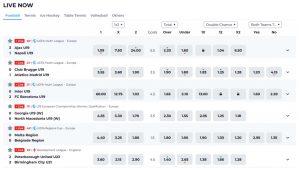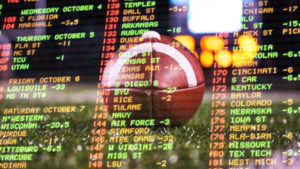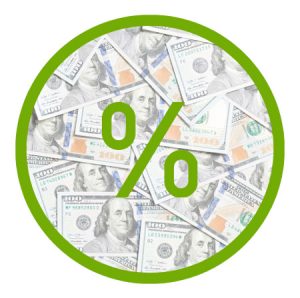 Author:
Webster Lupton
| Last Updated:
June 2025
Author:
Webster Lupton
| Last Updated:
June 2025
Closing line value, or CLV betting, is the gap between the odds you bet and the odds available immediately before gametime. It helps you determine how you’re performing against the market and is a powerful tool for sports betting success.
Of course, you’ll need to learn more about CLV betting before the success comes. Keep reading as we discuss what closing line value is, how to calculate it, examples, tips, and common misconceptions.
Closing line value measures the odds you’re getting on a game versus the sportsbook’s closing price. It essentially reveals whether you’re making informed bets that beat the market.
As you probably know, bookmakers post opening lines and move them throughout the week based on injuries, sharp money, and more.
Your goal is to consistently place wagers with positive closing line value. If you make a spread bet at -2.5 and the line closes at -3, for example, you’re getting +CLV.
In contrast, negative closing line value indicates that your wagers have a lower chance of success. An example of -CLV would be you betting on a -200 moneyline, and the line closing at -180.
Negative or positive value closing line value doesn’t always show up in short-term results. For instance, you could place several +CLV bets and still experience a losing streak. Likewise, you might win multiple -CLV wagers in a row.
However, closing line value is still important for long-term results. You’re far more likely to be a winning bettor if you consistently outperform the final pregame lines.
How to Calculate CLVYou can roughly determine closing line value in betting by checking if you get better odds than the closing line. Of course, you might want a more exact way of determining your success rate.
Here’s where knowing how to calculate closing line value in sports betting becomes useful.
Let’s look at the formulas for calculating CLV with positive and negative moneyline odds:
Now let’s break down what everything in the formulas mean:
Some bettors like to remove the bookmaker’s overround (a.k.a., vig) from X. They do this for a more accurate representation on how they’re performing regarding CLV.
We suggest using an online calculator to easily remove the overround. Afterward, you simply treat the no-vig line as X in the formula.
As for calculating CLV for spreads, you must find the difference between the points/price you got and the closing points/price. A half-point calculator will help you determine this difference.
After getting your number, plug it into one of the formulas (usually negative moneyline) to determine closing line value.
We’ve covered how to calculate CLV in betting—now let’s get into examples involving moneylines and spreads.
We’ll start with a scenario involving a moneyline where you beat the closing line (positive CLV):
Now let’s look at an example where you’re getting negative closing line value:
Earlier we discussed how point spreads require a slightly different approach for closing line value. Here’s an example on determining CLV for spread betting:
Closing line value is helpful for measuring your sports betting success, but it doesn’t always reflect your results immediately.
Sports wagering features lots of short-term variance. You may be killing it with +CLV but still suffer losses over a 20- or 30-bet span. In some cases, you might get -CLV over and over, yet experience success as far as winnings.
Either scenario could lead you to dismiss the importance of closing line value, which would be a mistake. After all, the sharpest bettors are those who beat closing lines over time.
They treat CLV as a process metric rather than a short-term results metric. Sharp bettors track their bets and compare against closing lines to see if they’re consistently making good decisions. Over the span of hundreds or thousands of bets, +CLV decisions will eventually lead to profits.
Market Efficiency and Closing Line ValueThe reason why sports betting closing line value is so important is because it reflects a sportsbook’s most efficient odds.
By this point, the bookmaker has all the info they need—sharp money, public money, injuries, etc.—to develop an accurate line. If you beat closing odds more times than not, you’re placing wagers with positive expected value (+EV).
Of course, not all closing lines are the same. Highly liquid markets (e.g., MLB World Series) give bookies mountains of information, leading to more accurate closing lines.
The margin for CLV betting success with these markets is smaller due to the extremely accurate closing prices. Even the opening lines are normally sharper, making it more difficult to get +CLV with early bets.
Let’s contrast this to niche markets, like obscure sports or player props. You’re more likely to get soft opening lines with badminton totals or a Nikola Jokic rebounding prop than with an NFL playoff game.
Tips for Beating the Closing LineBeating closing lines regularly isn’t easy, but it can be done with the right approach. The following tips will give you a better chance at making +CLV bets.

Opening lines aren’t always winners, but they provide the best starting point for following games. You’re more likely to find bets that can beat closing lines earlier. Of course, prior knowledge of the sport/teams involved helps you quickly gauge early odds that could be soft.

We recommend signing up at multiple sportsbooks so you can compare and jump on favorable lines when necessary. Many sportsbooks move their odds in near unison, but some may lag behind. By taking advantage of these price discrepancies, you can get better odds and potentially +CLV.

Tracking your wagers is the first step towards measuring your performance with closing line value in sports betting. You’ll want to record your bet/odds, the final line, and +/- CLV. We also suggest analyzing these results from time to time while looking for patterns. You might find that you’re really successful with a certain market while you may struggle with another.

A sharpbook (i.e., accepts sharp money) typically has more accurate odds than a softbook (i.e., caters to rec bettors). Therefore, we like comparing sharp and softbook lines after a major injury or news. We’ll bet at the softer book if there’s a notable gap between the two, giving us a better chance to beat closing prices.

Closing line value only identifies when you’re making good decisions—it doesn’t lead you to profitable wagers on its own. You still need to study sports/betting markets, research key stats, and use helpful programs.
While CLV is an important betting concept, it’s not a magic bullet. Let’s discuss common misconceptions about closing line value and the realities behind them.

Positive CLV pays off over time, but it doesn’t guarantee anything in the immediate future. It’s a long-time process that requires patience and the ability to adjust when you’re regularly seeing -CLV.

Some bettors wrongly assume you need positive closing line value 70-80% of the time to win. You probably only need +CLV for over 50% of bets when including vig to be a long-term winner. For no-vig calculations, you’ll likely be profitable when getting +CLV 55-60% of the time.

Sharps and betting syndicates can cause line movement based on their action. You might be tempted to follow these movements thinking you’re betting with sharps. However, bookmakers move lines for other reasons too, like heavy public action, injuries, and weather changes.

We respect closing lines and think they’re great for measuring your betting decisions, but they’re not perfect. A closing line merely represents the bookmaker’s final estimation of market sentiment. Sometimes the market doesn’t accurately account for certain info that greatly influences a match. For example, Buster Douglas (42:1 underdog) drew extra motivation from his mom dying 23 days prior to his massive 1990 upset over Mike Tyson.
You should consider tracking CLV in betting to determine if you’re making smart wagers. You can simply use our formulas for each bet to see when you’re betting +/- closing line value.
We recommend shopping for lines shortly after they’re released for the best chances at +CLV. You should also track results and analyze them to see how you’re performing.
If you’re ready to start tracking closing line value now, you should check out our top sports betting sites. We’ve tested and reviewed these bookmakers to ensure they’re safe, have many markets, and offer worthwhile bonuses.

Webster Lupton is a veteran journalist, editor, author, and gambler. His book, A Place to Play, is a deep-dive on baseball history in North Carolina. Web enjoys camping, birdwatching, and fishing. From North Carolina, he likes betting on college basketball as well as NFL and college football. He’s a lifelong NY Giants fan.

